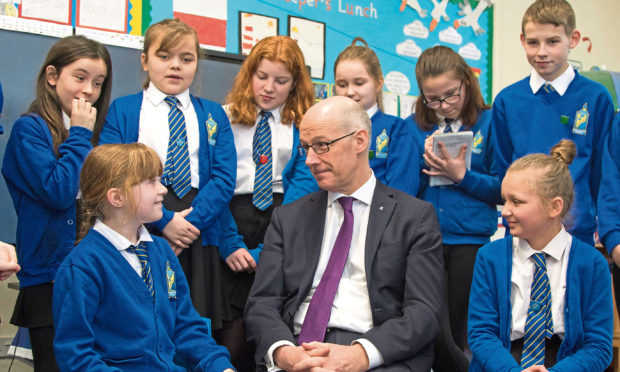The government’s potential humiliation over primary one tests is just the latest setback for the SNP in its dismal handling of education over the past decade.
John Swinney, the minister responsible, who is also the deputy first minister, was considered a fairly safe bet within the party, until he was given the schools brief.
But even this seasoned politician has come a cropper in possibly the trickiest department – after health – to manage and must long for the days when he only had the nation’s budget to balance over at Finance.
Swinney was put in charge of schools reform when his boss, Nicola Sturgeon, said she wanted to be judged on her record in education and vowed to make closing the attainment gap between rich and poor children in Scotland her priority.
By giving her most able colleague the job, she sent out a clear signal that she really did mean to do something about the country’s fast falling education standards.
It would be a major embarrassment, then, if the move to scrap primary one tests – which has all opposition party support – goes ahead, reflecting a total lack of confidence in the Edinburgh government.
But the SNP has committed worse education crimes than trying to impose assessments on five-year-olds.
Swinney had to abandon his flagship Education Bill in June and along with it his vision of empowering head teachers to set the curriculum, hire staff and control their own purse strings.
Most of these are basic responsibilities for managers in any other efficient business, but Scotland’s schools are still run by the unions, which are not interested in efficiency or, it seems, in education.
But perhaps more disappointing than the failure of Swinney’s proposed changes is the failure of the existing education strategy.
It came to light over the weekend that dozens of secondary schools are simply ignoring a government edict to teach all pupils a foreign language up to the end of S3.
In a survey by a Dundee University professor, Jim Scott, it was found that only 161 out of all 359 state secondaries were teaching a compulsory modern language for three years.
The other schools either thought language teaching to this level was an optional requirement or they didn’t provide information about what their provision was.
Acquiring languages not only makes youngsters more employable but is also believed to improve literacy and numeracy.
In Scotland, the number of children passing French at S4 has decreased by almost two-thirds in just four years. There has been a 30% reduction in qualified French teachers in the past 10 years and a 45% drop in German teachers.
These represent a staggering decline in subjects that were once a mainstay of the secondary curriculum. Has the government not noticed or is this another education problem for the too hard basket?
Considering the importance Sturgeon places on Scotland being a part of the wider European community, it does seem extraordinary that there is so little effort in making Scottish children more EU friendly.
Schoolchildren in Brussels or Paris or Madrid are often bilingual or trilingual by the time they leave school and will transfer seamlessly between countries and, in the future, between jobs, no doubt.
Outside the EU, as we will soon be, languages such as Mandarin or Arabic will become as useful as French, Spanish and German and should be valued along with maths and science.
Several of the big employers, including in the city, have two piles for job applications, one for those with language skills and one (the slush pile) for those without. Scottish job seekers are disadvantaged before they even reach the interview stage. The British Council’s Alice Campbell-Cree, who edited the Languages for the Future report, wrote last year that Britain ‘will need to reach out, within and beyond Europe, to maintain and improve our economic position, to build trust, strengthen our international influence and cultural relationships, and to keep our country safe’.
To do this, the next generation must be able to connect with people around the world and speak their languages. But even when this message is spelt out, in English, Scotland’s politicians don’t understand.
The nationalists are not the only party to have made empty promises over education; other politicians from other persuasions have come into office with hopes of enriching young people with the gift of good schooling. They have all been thwarted by teachers’ unions, fearful of losing their grip.
But the SNP has been in government for a long time, and has enjoyed comfortable majorities in some of those years.
If education reform had been as high up the agenda as, say, constitutional change, would today’s Scottish teenagers be struggling to match the achievements of their counterparts in Europe, England included, where education standards are now generally higher?










